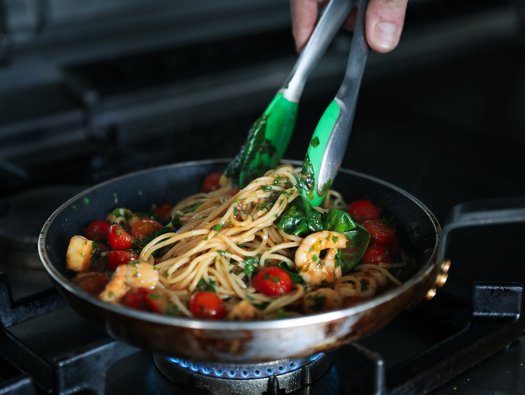Nathan Outlaw’s Fishghetti

This is a really tasty dish. Despite containing tomatoes, it is still low in potassium per serving.

This is a really tasty dish. Despite containing tomatoes, it is still low in potassium per serving.
150g king prawns, raw and peeled (approx. 12)
100g scallops (approx. 4)
100g of cod or ling
150ml of tomato juice
200ml fish stock (use low-salt stock if possible)
1 garlic clove
20 cherry tomatoes
350g of spaghetti
75ml of rapeseed oil
10g basil
40g spinach
10g parsley
Black pepper
Slice the fish and scallops into similar sized pieces. This will ensure that it will cook evenly. so that all the seafood is a similar size, so that it will cook evenly. Peel and finely chop the garlic and roughly chop the basil and parsley.
Make up the fish stock and add to a pan, along with the tomato juice. Bring to a simmer over a medium heat and cook until the liquid has reduced by half, about 10 mins. Halve the cherry tomatoes.
Add the spaghetti to a pan of boiling water and cook according to the instructions while you prepare the sauce. Stir occasionally until just cooked, then drain immediately.
In a large frying pan, heat the oil gently and add the garlic. Once the garlic begins to colour, add the prawns, scallops and fish. Fry gently for 3-4 mins.
Pour the fish stock and tomato reduction into the seafood. Then, add the cherry tomatoes, parsley, basil and spinach. Simmer for 2 minutes and then take off the heat.
Once the spaghetti is cooked, put the sauce back on a low heat. Add the spaghetti to the pan, toss it well to combine and then season with black pepper. Serve immediately.
The spaghetti is the main sources of carbohydrate in this recipe and the value has been provided for those who have been trained in insulin adjustment.
Although this dish contains some high potassium ingredients, such as tomato juice, cherry tomatoes and spinach, the amounts used are minimal to ensure the entire meal is still low in potassium and can be enjoyed as part of a low potassium diet.
Despite also containing some ingredients high in phosphate, such as prawns and scallops, overall, this dish is low in phosphate and can be enjoyed as part of a low phosphate diet.
This meal still contains some phosphate, so if you have been prescribed a phosphate binder, ensure you take them with this dish.
The seafood used in this recipe provides a good source of protein which is great for people receiving dialysis who need to eat more protein. If you have been advised to eat a low protein diet, use a smaller portion of seafood, about third of the recipe portion.
Use a gluten-free stock cube and spaghetti.
There is no added salt in this recipe, but it is found naturally in the seafood. It is only slightly above the range to be classified a low salt dish. Choose a fish stock cube with the lowest amount of salt.
This dish is best eaten immediately. However, if storing, then allow to cool and store in an airtight container in the fridge for up to two days. Reheat thoroughly before serving.
For those with a transplant, it is best to purchase your fish pre-packaged.
In the right amount and served with the right foods, tomatoes can still be enjoyed safely by people who have been advised to lower potassium in their diet. Laura Kyte, Renal dietitian at the Royal Devon and Exeter NHS Trust, offers advice about eating tomatoes if you are living with CKD.
You can enjoy a wide variety of delicious and healthy food when you are living with kidney disease. All Kidney Kitchen recipes are analysed and approved by kidney dietitians. Search through our kidney-friendly recipes or filter them by category below.
Sea bass is great for a simple supper or for a dinner party. Try this all-in-one dish, with accompanying soused vegetables and smoked paprika potatoes.
By giving us your email address, you're giving us permission to send you the latest news from Kidney Care UK. Further information about how we protect and use your personal data is available in our Privacy policy. If you would like to change the way we communicate with you at any time please email [email protected]. You can unsubscribe at any time by using the link at the bottom of every email we send.